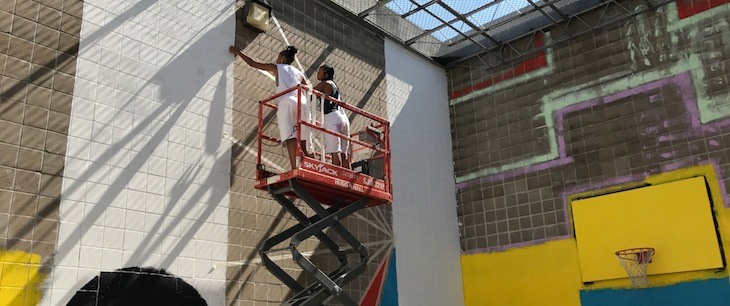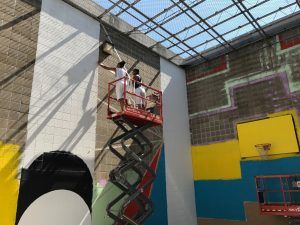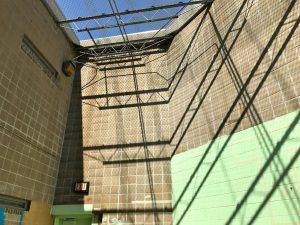Juvenile detention center mural unites a community: It’s ‘what art should be’
by July 27, 2017 4:04 pm 2,824 views

In the heart of the Sebastian County Juvenile Detention Center, there is a triangular atrium known as “the rec yard.” Thirty feet of cement brick climb into the air, allowing little sunlight through the mesh and steel-reinforced ceiling. What does get in — on a scorching summer day — can turn the place into a virtual tinderbox.
There is a basketball goal, a weight station (minus the weights), and a blank, desolate atmosphere that hints at the hopelessness the 20-50 young inmates cycling through here are destined for, if they stay on the wrong side of law and order.
It’s a place where one can be forgotten by society.
Over the last week, there has been a drastic change taking place here. Teams of community volunteers — working in conjunction with JDC staff — are lending their efforts. Stephen Gebhart, vice president of operations for Mercy Clinic-Fort Smith, is power-washing the walls so London-based artist Lakwena and her sister Abbi Maro — along with their “assistants” — can splash-and-roll on some brightness. To an observer unfamiliar with what the six white-clad artists are doing, it seems a message is developing that goes beyond shapes and color. But it isn’t quite clear what the message is.
Yet.
Lakwena has never painted inside a detention center or prison before, but when she was presented with options for her contribution to The Unexpected, she immediately fell in love with the project.
“I thought, ‘Yes, yes, yes, yes,'” Lakwena told Talk Business & Politics in a recent interview. “I think, working on it, it’s like my favorite job I’ve ever done on so many levels. The space is incredible, but then the significance of it being in here. It’s like the ideal, dream job. And working with the community — we’re all working together. It’s exactly what art should be.”
If you look closer at Lakwena’s four assistants, they’re young — one day, female; another, male — and like Lakwena and Abbi, they are grimy, covered in sweat, and loving every minute of the creative process. One of the girls, during a much-needed break, tells Charlotte Dutoit, “You know what, it’s hot, but I prefer to be here all day than to be burrowing inside.” Dutoit is curator for Justkids and the woman, who brought Lakwena to The Unexpected for its third annual celebration.
The boys, Lakwena said, are “quite playful” and eager “to just splash on the paint.” The girls were “a bit shy in the beginning,” but “after a time, they just loosened up. Like me.”
One would never know from observing the eight youths they are inmates at the detention center, hand-selected by JDC staff based on good behavior. That good behavior has translated well to the project, Lakwena said.

“They’re working really well. Perhaps I shouldn’t say this, but better than quite a lot of adults I’ve worked with. They’re brilliant. We’re not having to push them and say, ‘Work harder.’ They’re really hard-working, really focused, really driven, and really loving it. We’re having to convince them to take breaks!”
HOW IT BEGAN
If you ask Claire Kolberg of The Unexpected, it was the Leadership Fort Smith Class of 2016 that launched the effort. A class field trip to the facility left an impression on the 25-member group. “They (JDC staff) took us out into the rec yard, and the officer said, ‘You know, these kids, this is what they see,” said Lorie Robertson, a class member and the director of marketing for the Fort Chaffee Redevelopment Authority (FCRA). “It was very drab and dreary and uninspiring, and you have to remember: these are kids, teenagers.”
Allison Montiel, a nurse and mother of five, was the first to mention the idea when brainstorming topics for a class project. The idea picked up steam with individuals like Jeremy May, lead marketing analyst, special projects, for ArcBest Corporation. Mercy next stepped up as sponsor to bring Lakwena to The Unexpected and fund the needs of the project.
Martin Schreiber, vice president of Mission for Mercy, said Mercy connected with the project because, “We always wanted to make sure voices not heard in the commuity are heard,” adding that the mural was Mercy’s way of “showing solidarity” to the young people at the facility. You always think of people in ‘these parts of the world,’ and it just so happens they’re in our town, and they can become forgotten. Mercy just wanted to say, ‘No one is forgotten, and no one is invisible.’”
Before turning Lakwena loose on the creative aspects of the mural, Mercy emphasized it “wanted these young people to see that they have something beautiful inside of them,” Schreiber said.
Lakwena then turned to the words of author, poet and Arkansas native Maya Angelou for the finished product.
“Most of my paintings tend to use words,” Lakwena explained. “And while you can never force what someone is going to receive from art, my intention is the words that we paint on this wall are going to be words that echo in their minds and in their hearts.”

For the final messaging, Lakwena chose the title from one of Angelou’s most famous poems to show the young inmates they can rise above the JDC walls and that no layer of steel and mesh can stop them.
‘STILL A TOMORROW’
It was a creative choice that agreed with Mercy and Leadership Fort Smith, but both bodies acknowledged the project didn’t start with them, but rather JDC staff members like retired Capt. Fran Hall — who stepped away as administrator of the detention center in 2015 after 19 years on the job and 39 in law enforcement — or retired Sgt. Steve Wilhelm, who left in 2017 after a 26-year career.
“When these kids look at that mural,” Wilhelm said, “they will be able to sit back and reflect on their situation — how they got there, whose fault it was — and they can see that mural and realize, there is still a tomorrow.”
Wilhelm spent much of his career as the “tough love” guy, who didn’t mind “scaring the Heebie Jeebies” out of inmates if that’s what it took to reach them. His motto: “If I could get through to just one in my 25 years, 10 months, and four days, it was worth it. And that’s the same thing with this mural,” he told Talk Business & Politics. “Just one. If it can change their lives, it’ll be worth it. And it shows them there is somebody out there who still loves them. That there is still somebody out there who cares. Somebody had to come here to make this and do this. They need to ask why. Why? And when they ask why, the answer is, somebody cares.”
That “somebody” can still be found at the JDC, Wilhelm said, remembering words some of the kids had said to him over the years. “Mr. Steve, I wish I had met you sooner in my life. Mr. Steve, I wish you was my daddy. Well, we’ve still got a lot of good deputies down there being looked up to, and they’re role models.”
Hall’s and Wilhlem’s work continues through individuals like Lt. Leslie Asbury and Sgt. Laura Stallings. Asbury and Stallings provided access and anything The Unexpected needed to complete the project. They were also the first to suggest to Leadership Fort Smith that “these kids need something inspiring,” Robertson said.
In the end, the project has gone far beyond idea and far beyond the confining space where it will remain. It is a community project most of the community will never see; but for the ones who will, it will be a powerful reminder of the words Capt. Hall recently shared with the kids of the JDC. “Look how many people in this community love you.”
Arkansas Gov. Asa Hutchinson heard about the project and has scheduled a stop at the facililty to see the finished mural and visit with the youths who helped create it on Friday (July 28). When he arrives, he will see waves of color splashing across the floor and into the sky with Angelou’s words adorning each of the once hopeless walls: “Still I Rise.”
